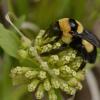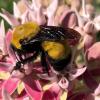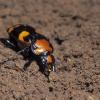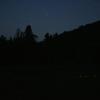
(Gastropoda: Pulmonata: Oreohelicidae)
The Black Hills mountainsnail is a land snail that was once widespread and abundant throughout its range, but is now rare and critically imperiled. It is endemic to the forests of Black Hills, an isolated mountain range in western South Dakota and northeast Wyoming. It is closely associated with moist areas and limestone or dolomite substrates that contain high levels of calcium for shell maintenance. This species is an indicator of ecosystem health; it is very sensitive to habitat disturbance since it requires a moist habitat and cannot disperse fast. The Black Hills mountainsnail was recommended for listing under the Endangered Species Act by experts in 1993. However, the U.S. Fish and Wildlife Service has not moved forward to protect this species and its populations have continued to decline due to habitat loss and degradation.
Much of the following information is adapted from the petition to list the Black Hills mountainsnail under the Endangered Species Act (Biodiversity Conservation Alliance et al. 2003).
The cooperi taxon was originally described as a full species, Oreohelix cooperi (Binney 1859), but later assigned to the subspecies Oreohelix strigosa cooperi (Shimek 1890). However, cooperi appears to have been incorrectly assigned as a subspecies of Oreohelix strigosa (Biodiversity Conservation Alliance et al. 2003), Frest and Johannes 2002), and is more appropriately recognized as a distinct species. Furthermore, the cooperi taxon is morphologically and/or anatomically distinct from other related Oreohelix forms, a factor that further supports recognition as a full species (Frest and Johannes 2002).
The Black Hills mountainsnail is also commonly known as Cooper’s rocky mountainsnail.
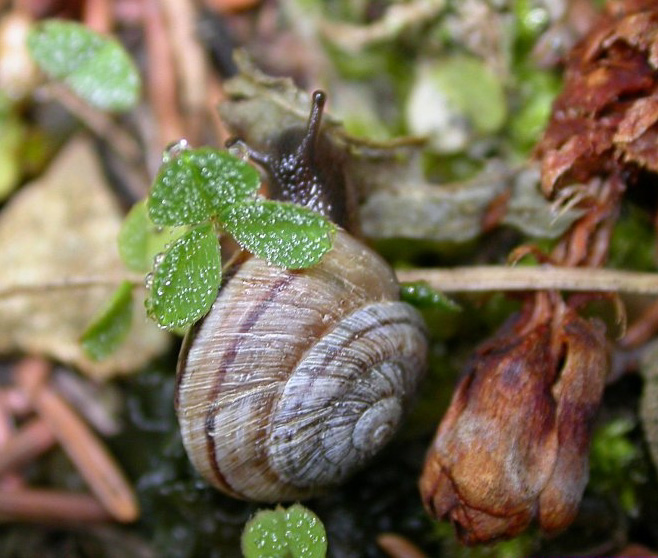
The following information is adapted from the petition to list this species (Biodiversity Conservation Alliance et al. 2003).
The Black Hills mountainsnail is the largest of mountainsnails in the Black Hills region, distinguishing it from the similar yet smaller Pahasapa mountainsnail (Oreohelix new species 1) (Frest and Johannes 2002).
From Frest and Johannes (2002)
Juveniles of this comparatively thick-shelled subspecies (sic) generally hatch at 2-2 ¼ whorls. They are even brown, moderately convex above, and have a weakly pronounced keel. Most range between 3.5 to 4.0 mm in diameter. For the first two whorls, the ornament consists of fine but distinct and regular subequal spiral ribs and transverse ribs, with rib width being generally equal to interspace width. In the last quarter to one-half whorl, several larger low transverse riblets (lirae) appear, usually three on the upper surface and six on the lower. Intersections of lirae and radial ribs are accentuated by low, triangular perostracal hairs. These are the most prominent on the keel, and continue until the 3-3 ½ whorl stage is reached. Transverse striation on the adults is usually noticeable, but patchy. Radial striation is most distinct on adults (i.e., specimens with more than 3 to 5 ¾ whorls). As is typical of Oreohelix, the striation (actually accentuated growth lines as much as ornament; hence the irregularity) is the most strong on the upper half whorl, and somewhat subdued below. Accurate counts are difficult because of unequal and irregular development, but 4 per mm on the last half whorl of adult specimens is typical. Most adults have 5-5 ¾ whorls. (p. 85)
The following is adapted from the petition to list this species (Biodiversity Conservation Alliance et al. 2003).
Intact and undisturbed riparian areas are very important to the Black Hills mountainsnail (Frest and Johannes 1993, 2002). Many Black Hills mountainsnail colonies are also associated with springs (Frest and Johannes 2002). Upland sites with “mature”forest plant communities are also reported to be important for the Black Hills mountainsnail (Frest and Johannes 2002). Abundant coarse woody debris is usually an important component of Black Hills mountainsnail habitat, often serving as a refuge for snails in areas where extensive habitat degradation has occurred or is occurring (Harmon et al. 1986, Olson 1992, Frest and Johannes 2002).
The Black Hills mountainsnail feeds primarily on decayed deciduous tree leaves and other degraded herbaceous vegetation. The species has been observed to crawl on downed wood, tree trunks, and limestone talus blocks (Frest and Johannes 2002), although the species is not physically capable of moving beyond suitable habitat due to the threat of desiccation and predation, and because of the species’ forage needs. (Frest and Johannes 1995a, 1997, 2002). It is thought that it takes up to two years for the Black Hills mountainsnail to mature and that they may live anywhere from 2-6 years (Frest and Johannes 1991, 2002). The species breeds at least once during a lifetime and usually breeds only once a year, depending on environmental conditions (e.g., moisture, temperature). Oreohelix species do not lay eggs, but rather the young hatch internally within adult snails (Frest and Johannes 2002). The Black Hills mountainsnail may co-occur with other rare land snail species including the callused vertigo (Vertigo arthuri) and Cockerell’s striate disk (Discus shimeki), both of which are identified as species of concern on the Black Hills (Frest and Johannes 1993, 2002). The Black Hills mountainsnail is also reported to co-occur with several plant species that are considered rare and/or disjunct in the Black Hills.
The Black Hills mountainsnail is extremely sensitive to environmental change (Frest and Johannes 2002). Indeed, no colonies have been observed in heavily grazed or logged areas (Frest and Johannes 1993, 2002). Road construction, domestic livestock grazing, logging, and forest fires have all adversely affected colonies in the Black Hills (Frest and Johannes 1991, 1993, 2002). The species is preyed upon by rodents, other small mammals, amphibians, reptiles, birds, insects, and insect larvae (Frest and Johannes 2002, Hall et al. 2002). The Black Hills mountainsnail may be preyed upon by the endemic Black Hills red-bellied snake (Storeria occipitomeoculata pahasapae) (Hall et al. 2002), a former category 2 Candidate subspecies and a subspecies of concern in the Black Hills (USFWS 1994, USFS 1996). Parasitism by insect larvae may also cause mortality of O. cooperi (Pilsbry 1939, Frest and Johannes 2002).
The following is adapted from the petition to list this species (Biodiversity Conservation Alliance et al. 2003)
The genus Oreohelix is endemic to western North America (Pilsbry 1939). The Black Hills Mountainsnail is endemic to the Black Hills mountains of western South Dakota and northeastern Wyoming. The species is presently rare, but was once abundant and widespread (Frest and Johannes 1993).
20 colonies are on land managed by the U.S. Forest Service; 2 are on USFWS land; 1 colony is on land managed by the City of Spearfish, South Dakota, and 9 are on private land (Frest and Johannes 2002). Two colonies have been documented as extirpated since 1993, and remaining colonies are not secure.The following content was adapted from the petition to list this species (Biodiversity Conservation Alliance et al. 2003).
The following is adapted from the petition to list this species (Biodiversity Conservation Alliance et al. 2003)
This species was once common and widespread throughout its range, but has undergone significant decline over the past century (Frest and Johannes 2002). Only 32 colonies of this species remain, and there has been a population of at least 20% since surveys in the early 1990s , and is rare or uncommon at 56% of extant colonies (Frest and Johannes 2002).
The Black Hills mountainsnail was designated a category 2 Candidate species by the USFWS, and in 1996 this category of protection was eliminated and the species was dropped as a Candidate species. Frest and Johannes (1993) recommended that this species be listed as Endangered under the Endangered Species Act.
Despite the noted decline of this species and its rarity, little to no action has been taken to protect remaining populations.
The following is adapted from the petition to list this species (Biodiversity Conservation Alliance et al. 2003)
Domestic livestock grazing poses significant threats to the species, as well as logging, mining, herbicide application, road construction, and other damaging activities (e.g., recreational activities, spring developments) (Frest 2002, Frest and Johannes 1995, 1997, 2002). And, because of the susceptibility of the species to desiccation and predation, and the limited motility of the species, most Black Hills mountainsnail colonies are extremely vulnerable to the effects of anthropogenic or natural environmental change (Frest and Johannes 1993, 2002). Fragmentation of habitat and colonies has also placed significant limitations on the ability of the species to recover from the impacts of anthropogenic and/or natural environmental change (Frest and Johannes 2002). While more Black Hills mountainsnail 26 colonies could be found in the Black Hills, it is not believed that a sufficient number will be found to justify any less concern over the status of the species (Frest and Johannes 2002). The species remains threatened with extinction (Frest and Johannes 2002).The following information was adapted from the petition to list this species (Biodiversity Conservation Alliance et al. 2003).
The following is adapted from the petition to list this species (Biodiversity Conservation Alliance et al. 2003)
The Black Hills mountainsnail (Oreohelix cooperi) is a critically imperiled land snail species that warrants listing as threatened or endangered and therefore warrants critical habitat designation. The benefits of ESA listing for the Black Hills mountainsnail are substantial, as we suggest throughout this petition.
The result of listing will be significantly improved protection on federal lands from domestic livestock grazing, logging, road construction, herbicide and pesticide use, mining, spring developments, recreational activities, and other potentially detrimental activities in the form of a proactive approach to implementing conservation actions prior to allowing any Black Hills mountainsnail habitat to be impacted.
The designation of critical habitat, yet another exclusive benefit of ESA listing, will result in significant additional protection not only for occupied habitat but also for other habitat areas deemed essential to the recovery of the species. The ESA prohibits adverse modification of designated critical habitat.
Binney, W.G 1859. Notes on American Land Shells. No. 3. Proceedings, Academy of Natural Sciences of Philadelphia 1858:114-116.
Biodiversity Conservation Alliance, Center for Native Ecosystems, Native Ecosystems Council, Prairie Hills Audubon Society, The Xerces Society, Nichols, J. 2003. Petition for a Rule to List the Black Hills mountainsnail (Oreohelix cooperi) as THREATENED or ENDANGERED under the Endangered Species Act 16 USC 1531 et seq. and for the designation of Critical Habitat.
Frest, T.J. and E.J. Johannes. 1991. Survey of Spearfish Canyon and vicinity, Black Hills, South Dakota and Wyoming, for Oreohelix strigosa cooperi (Binney, 1858) and associated land snails. Final Report. USDA Forest Service, Black Hills National Forest and USFWS South Dakota State Office. Deixis Consultants, 2517 NE 65th St, Seattle, WA 98115. 59 p.
Frest, T.J. and E.J. Johannes. 1993. Land Snail Survey of the Black Hills National Forest, South Dakota and Wyoming. Final Report to USDA Forest Service and USDI Fish and Wildlife Service. Deixis Consultants, 2517 NE 65th St, Seattle, WA 98115. 156 p.
Frest, T.J. and E.J. Johannes. 1995. Interior Columbia Basin Mollusk Species of Special Concern. Final Report to Interior Columbia Basin Ecosystem Management Project. Deixis Consultants, 2517 NE 65th St, Seattle, WA 98115. 362 p.
Frest, T.J. and E.J. Johannes. 1997. Land Snail Survey of the Lower Salmon River Drainage, Idaho. U.S. Department of the Interior, Bureau of Land Management, Idaho State Office, Boise. Idaho Technical Bulletin 97-18. 142 p.
Frest, T.J. and E.J. Johannes. 2002. Land Snail Survey of the Black Hills National Forest, South Dakota and Wyoming, Summary Report, 1991-2001. Final Report to the USDA Forest Service, Black Hills National Forest. Deixis Consultants, 2517 NE 65th St, Seattle, WA 98115. 127 p.
Harmon, M.E., J.F. Franklin, F.J. Swanson, P. Sollins, S.V. Gregory, J.D. Lattin, N.H. Anderson, S.P. Cline, N.G. Aumen, J.R. Sedell, G.W. Lienkaemper, K. Cromack, jr., and K.W. Cummings. 1986. Ecology of coarse woody debris in temperate ecosystems. Advances in Ecological Research 15:133-302.
Olson, D. 1992. The Northern Spotted Owl Conservation Strategy: Implications for Pacific Northwest Forest Invertebrates and Associated Ecosystem Processes. The Xerces Society, 4828 SE Hawthorne Boulevard, Portland, OR 97215. 50 p.
Pilsbry, H.A. 1939. Land Mollusca of North America North of Mexico. Academy of Natural Sciences of Philadelphia, Monograph 3, vol. 1, part 1.
Shimek, B. 1890. The Mollusca of eastern Iowa. University of Iowa Studies in Natural History 1:56-81.
USFWS. 1994. Endangered and Threatened Wildlife and Plants; Animal Candidate Review for Listing as Endangered or Threatened Species; Proposed Rule. 59 Fed. Reg. 58982-59028 (November 15, 1994).
USFS. 1996. Revised Land and Resource Management Plan Final Environmental Impact Statement for the Black Hills National Forest. Custer, South Dakota.
The Xerces Society for Invertebrate Conservation

